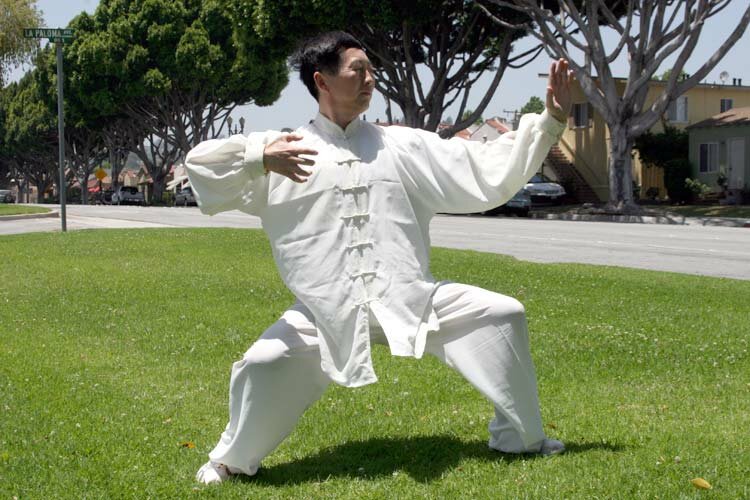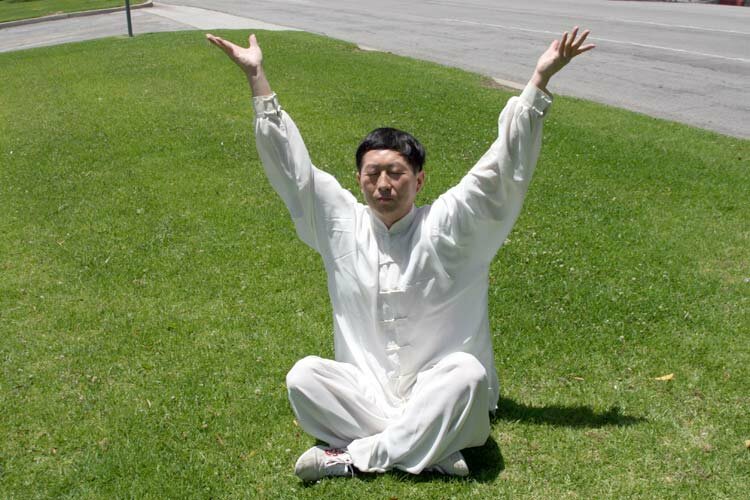|
No matter how well a martial artist knows his form or techniques, it will be of little use in fighting or tournament competition unless his body is well-conditioned—both externally and internally. The need for physical fitness is not a new concept to fighting styles.
Long before specialized weight training equipment appeared in training halls, martial artists dating back 2,000 years were developing methods to stay healthy and physically fit.
Some of the earliest written history involving martial art breathing exercise and physical fitness doctrines originated in ancient China. The evidence indicates that Chinese martial artists and physicians have long collaborated on martial arts and health.
During the later part of China's Eastern Han dynasty (A.D. 25-220) and the first portion of the Western Jin dynasty (A.D. 265-319), Chinese medicine progresses immeasurably and medicine embraced eight vital areas: theory, acupuncture, diagnosis, pathology, herbal medicine, prescription, dietetics and veterinary science.
Birth of Surgery
At that time, the amputation of limbs was commonplace. Noted physician Wang Shuhe wrote how disease can be diagnosed through the reading of 24 types of pulse rates. Well-known physician Ge Hong contributed toward the development of pharmaceutical science through his writings and knowledge of chemicals, such as mercury, sulfur, lead, copper and iron.
Perhaps the period's most famous physician was surgeon Hua Tuo, who was among the first to use anesthesia for abdominal operations.
Legends describe Hua Tuo's uncanny ability to remove tumors without touching the patient.
However, Hua Tuo is best known for his contribution to health and longevity through his wu qin xi (five animal games). Based on the study of the movements, sounds and breathing techniques of the tiger, deer, bear, ape and bird. Hua's wu qin xi was a series of exercises designed to improve health and add years of useful life.
“The human body requires constant exercise," Hua wrote, "and regular exercise aids digestion, stimulates circulation, and helps the body to resist disease."

Animal Breathing
Hua Tuo stresses the importance of imitating each animal's personality and physical characteristics. Hua Tuo theorized that each animal contributed to the health and longevity of his vital organs through individual breathing patterns and sounds.
One Hua disciple who practice the five animal exercises diligently was said to have lived over 100 years. Another follower, Wu Pu, was said to have had perfect teeth and acute hearing and sight well into his 80s.
Soon Hua's five animal exercises were practiced widely by the Chinese population, and ancient martial artists quickly incorporated the five animal exercises into their training regiments. The internal development and strength created by the five animal exercises blended perfectly with the martial artists' external practice and conditioning.
Hua Tuo based his five animal exercises on dao yin, a group of health and fitness exercises first recorded during the Western Han dynasty. Said to be the forerunner of tai ji quan (tai chi chuan), dao yin exercises reportedly not only conditioned and strengthened the body, but also cured ailments of varying magnitude.
Chinese Influence
Many of today's most common martial art stretching and limbering exercises are virtual twins of the original Chinese dao yin movements. For instance, the description of the original 11 dao yin exercises bears a strong resemblance of today's martial exercises.
* While holding a staff with both hands, stretch and twist the body.
* Bend forward at the waist and touch the palms to the floor.
* For relaxation, let both hands hang naturally below the waist, while slightly bending the knees. (This is one of the first, and one of the most important, postures of tai ji quan.)
* Kneel or sit cross-legged on the floor and twist the body, at the waist, in each direction.
* While standing with knees slightly bent, extend the arms to shoulder level (another early movement of tai ji quan).
* Sit on the floor and use your hands to bring both knees closely to the chest.
* While standing erect, and with both palms turned upward, raise both hands sideways to shoulder level.
* Stand erect, and with palms facing downward, bring both arms forward and up to shoulder level.
* While standing upright, cross both arms over your head.
* Breathe deeply while standing upright and bring both arms up and around to the rear in the circle.
Hua Tuo also stressed the importance of different breathing patterns designed to strengthen individual body organs. To each breathing technique he added a sound similar to the perceived personality of that animal.

Hua Tuo's wu qin xi should not be confused with the wu xing (shaolin five animal techniques) of the later period. The shaolin five animal techniques (snake, tiger, leopard, dragon and crane) were developed as fighting techniques in conjunction with martial art training within China's famed Shaolin Temple. Hua Tuo’s five animal games, on the other hand, were designed originally to improve health.
The five animal exercise was so important to Chinese medicine that some of its principles are still practiced in many of China's modern health care facilities. Researchers have found that using wu qin xi exercises produces better results than using drugs alone.
Eight Health Jewels
During the Tang dynasty (A.D. 618-907), a group of exercises were developed to complement the internal health benefits derived from the tai ji quan. Called ba duan jin (eight pieces of jewels), the exercises were so named because of their great health value.
Ba duan jin exercises are usually practiced just before the tai chi form to loosen the muscles and relax the body. Today's ba duan jin exercises are a revised version of the original movements.
Both hands holding the sky to harmony the triple warmer. The triple warmer is a Chinese medical term representing the upper, center and lower portions of the body. Therefore, this exercise benefits the eyes, ears and the face of the upper warmer; the lungs, liver, spleen and digestive tract of the center portion; and the sexual virility of the lower part of the body.
It is performed by stooping as if to pick up a heavy object, turning the palms upward as the body moves into an erect position, and pushing up to the sky while standing on tiptoes. As the ba duan jin practitioner lowers himself into the stooping position to repeat the exercise, his arms come down in a circular pattern. All ba duan jin exercises are repeated eight times.
Open the bow left and right to shoot the hawk.
Designed to condition and lubricate joints, this movement begins from a relaxed attention position. The practitioner, using either foot, steps to the side and into a low square stance. Next he crosses both arms, right arm on top. While looking to the left, he extends both arms, right arm on top. While looking to the left, he extends his left arm to the side, forefinger pointing up and thumb stretched toward the rear. He simultaneously pulls his right arm, bent at the elbow and first clenched back to the right at ear level, as if drawing a bow. This is repeated eight times on each side.
Stretch one hand down to the feet and then the other.
This promotes harmony between the spleen and the stomach, and helps with digestive problems. The tai ji quan stylist begins with his body upright and feet at the shoulder width. He raises one arm, palm directed upward, and simultaneously pushes down with the other palm, as if he were pushing the sky on one side and the ground on the other.
Turn the head and look backward.
It helps prevent respiratory diseases and improves circulations in the upper body. The tai ji quan practitioner stands upright, with feet at shoulder width and arms hanging loosely at his side, and slowly turns his head as far as it will comfortably rotate. Do this eight times for each side.
Squat down and hold the fists tight with an angry eyes.
Designed to develop and improve chi (internal energy), this exercise begins with the practitioner in a low stance position, his arms folded and his fists at the sides. While looking forward with angry eyes, he extends one fist forward. As that fist returns, the other is pushed forward in the same manner. Do each exercise eight times.
Stand up on the toes and bounce seven times.
This is a general body-toner that also aids in the prevention of disease. With the feet at shoulder width, the ba duan jin practitioner stands upright on his toes and bounces seven times before returning to his starting position.
Wiggle the tail and swing the head to release the fire in the heart.
Said to prevent or aid in the cure of heart disease. From a square stance position, palms on the thighs, the ba duan jin stylist lowers his head, bends his upper body forward and moves it in a circle. He should lean as far forward and as far back as possible in the course of his movements. Do this eight times in each direction.
Put the hands to the ground and grab the toes.
It benefits the lower back and kidneys. With his feet together, the practitioner slowly rotates his arm back and over his head before touching the toes.
Since ba duan jin exercises are performed at the same slow speed as tai ji quan, they can benefit practitioners of any age. Chinese martial arts are fortunate to have been influenced by ancient health exercises and theories. And this influence could help explain why many kung-fu stylists enjoy long, healthy lives.
The late Jane Hallander was a practitioner of choy li fit and I-chuan.
|